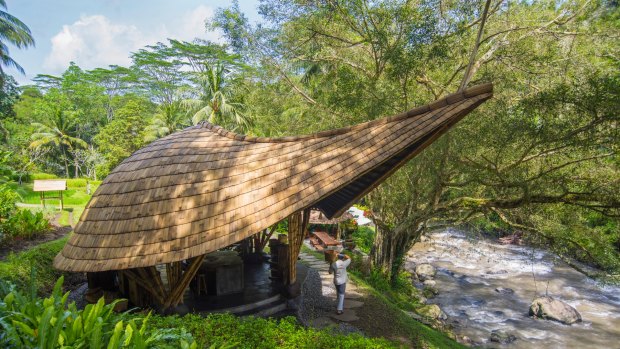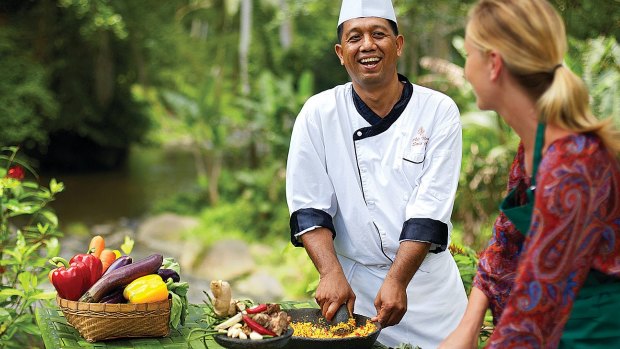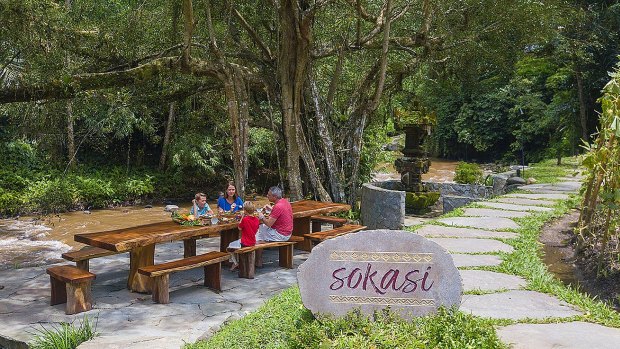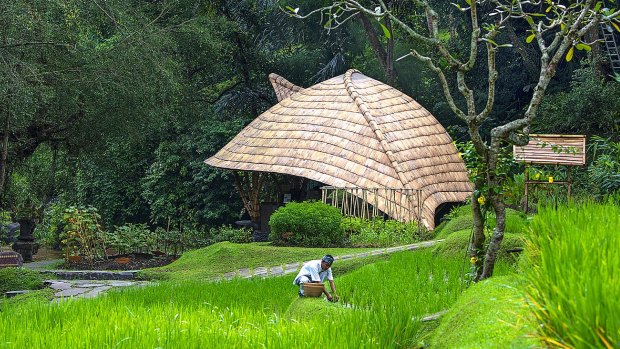This was published 5 years ago
The Sokasi Balinese cooking school: Bali's most beautiful cooking school

Sokasi Cooking School at Four Seasons Sayan, Bali
It's mid-morning when we gather on the banks of the rushing Ayung River at Sokasi – quite possibly the most beautiful cooking school I've ever laid eyes on. Named after a woven bamboo box used to store rice, the bamboo structure, with its clever leaf design, morphs from cooking school by day to candlelit chef's dinner table by night. It sits on the edge of Bali's longest river, part of the UNESCO Heritage-listed subak irrigation network.
The heart of Sokasi is a high-tech kitchen with a curvaceous stone table lit by woven lamps. Above us, hungry geckos hunt for food in the elaborate woven ceiling. Outside under a towering banyan tree, a table is set for lunch. It's here we'll gather to eat the food we've foraged and prepared with our own hands, with the gurgling river as a backdrop.

Family recipes and insights into local herbs are shared as part of the cooking class.
The custom-built cooking school opened earlier this year, adding to the Four Seasons Sayan's impressive repertoire of guest experiences. From its dazzling location among Bali's verdant highlands you can try river rafting (which the Obamas did during their stay), do yoga overlooking rice fields, and work up a sweat trekking in the jungle.
Set among lush vegetable gardens, abundant with Balinese limes, chilli, eggplant and herbs, the open-air school is designed by Elora Hardy, daughter of renowned jewellery designer John Hardy. It is designed to embrace the surrounding Sayan Valley and the island's diverse produce. All ingredients are locally sourced, right down to the coconut oil made by a staff member's aunty.
I've eaten Balinese food countless times since I first visited the island of the gods in the early 1990s – consuming way more nasi goreng and nasi campur than one should in one's lifetime. Frankly all of it pales in comparison to the dishes senior sous chef Wayan Sutariawan (Suta for short) shows us how to prepare. Suta not only shares family recipes and insights into local herbs, spices and aromatics during the half-day class, but teaches about Balinese life, too.

Sokasi Cooking School.
First off we're taught that the star of all Balinese dishes is bumbu, a Balinese paste made from ground roots and herbs, which is typically cooked by women. For big ceremonies, cooking becomes the responsibility of the men. Bumbu, also known as base genep, is the foundation of Balinese cuisine and it goes equally well with meat, poultry, seafood and vegetables. The only way to make it, Suta says with a smile, is by firing up your arm muscles – referring to the mortar and pestle we will make good use of later.
It was the making of bambu that got Suta thinking about a career as a chef. "I went to live with my aunty at 15 and every day I had to grind the spices for different dishes." Although Suta initially wanted to be a policeman, the daily domestic chore ignited a passion for cooking.
After donning aprons, we set to work chopping, slicing and working up a sweat grinding the fresh ingredients in an enormous mortar and pestle. My husband, usually a reluctant cook, and my 10-year-old daughter throw themselves into it with enthusiasm. While nearly all Balinese dishes use bumbu, somehow they manage to taste completely different. Sambal meanwhile, made with chilli, tomato and shrimp paste, gives a little extra heat and spice to Balinese food – the pop, so to speak.

Sokasi Cooking School.
Suta explains that the Balinese shop daily, as most have no refrigeration, and they cook just once, in the morning. Ubud is the district market but every village, including the one at Sayan, has a small daily market. Amazingly, food is harvested, sold and consumed daily, with virtually nothing stored. "Produce is harvested today and sold today," Suta explains.
Once the bumbu is ground, we saute it in fragrant coconut oil before it is added to beef to make sizzling satay sticks and lathered over snapper, which we wrap in banana leaves. It is also used for an aromatic vegetable curry. The sambal, which has a definite kick to it, is dolloped on top of fresh grilled tuna and tastes incredible. My daughter, typically not an adventurous eater, is spotted sneaking a spoonful of sambal (it is seriously that good).
When all the dishes are prepared, we sit down at a long table, steps from the river, with views of green rice terraces beyond. We listen to Suta's stories, laugh and feast on the dishes family-style, washed down with fresh coconut juice. Sokasi proves yet again there really is no better way to learn about a country's culture than through its food.
TRIP NOTES
Sheriden Rhodes was a guest of Four Seasons Sayan.
MORE
COOK
Cooking classes are available to both in-house guests and those not staying at the resort, priced from $US69 per adult; children $US34 (six to 11 years old), plus tax. Starting at 8am with a chef guided tour of Ubud Market (maximum of eight people), participants return to forage in Sokasi's vegetable and herb gardens, followed by the hands-on cooking class. Lunch is included. Learn about traditional Balinese cuisine, or take a class featuring plant-based menus. See fourseasons.com/sayan
STAY
Four Seasons Sayan offers 42 plush thatched pool villas and 18 suites overlooking the Sayan Valley, surrounded by rice paddies, gushing waterfalls, organic vegetable gardens and lotus ponds. Rooms from $US680 a night. See fourseasons.com/sayan
FIVE MORE BEAUTIFUL COOKING SCHOOLS
MARGAN COOKING SCHOOL, HUNTER VALLEY
Try a cooking class with Hunter Valley's pioneers of agri-dining, Margan Restaurant, overlooking the moody Brokenback Mountain Range. Classes span everything from knife skills, curing fish, pasta and cheese making through to handling and preparation of Perigold Black Truffles. See margan.com.au
WILD FOOD COOKING SCHOOL, NEW ZEALAND
Forage for indigenous herbs and spices in a pristine eco forest and learn the secrets of creating a hangi in this fascinating half-day cooking class. The Wild Food Cooking Experience at Treetops Lodge includes a 4WD tour of the lodge's 1010-hectare forest, a stroll through the bush collecting ingredients such as tangy kawakawa and peppery horopito, and a cooking class. See treetops.co.nz
COOKING ACADEMY, FOUR SEASONS NAM HAI, VIETNAM
At this farm-to-table cooking school guests learn to cook some of their favourite Vietnamese dishes. Start the day picking your own Thai basil, coriander , chillies and beans at the resort's farm, learn how rice paper is made, and then cook up a storm in the new Cooking Academy. Learn to make crispy spring rolls, tangy mango salad, Vietnamese pancakes and more. See fourseasons.com/hoian
RICK STEIN'S COOKERY SCHOOL, PADSTOW, UK
Lean to cook seafood in the charming fishing village of Padstow, also known as "Padstein", on Cornwall's north coast. The school's kitchen overlooks the Camel Estuary and uses ingredients literally straight off the boat that morning. Learn how to fillet fish, prep squid and prawns, make perfect sashimi, fish cakes and more. See rickstein.com/school
FLYING FISH, FIJI
With the languid Coral Sea as a backdrop, join this weekly hands-on cooking class at chef Peter Kuravita's feet in the sand Flying Fish restaurant at the Sheraton Fiji Resort. Participants craft a variety of dishes, from popcorn prawn skewers to the famous Fijian Kokoda, guided by Flying Fish chefs, tropical cocktail included. See sheratonfiji.com/flyingfish
Sign up for the Traveller Deals newsletter
Get exclusive travel deals delivered straight to your inbox. Sign up now.